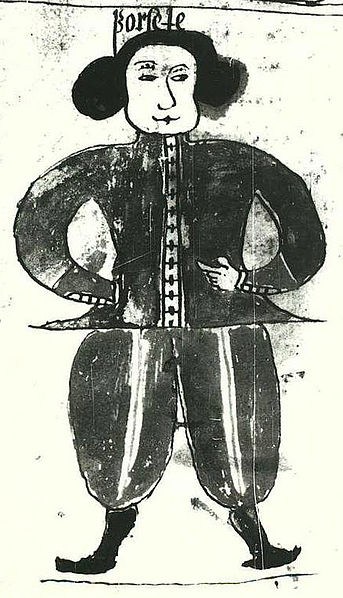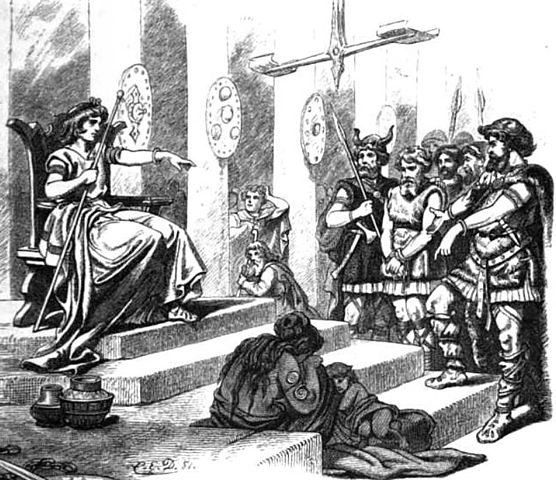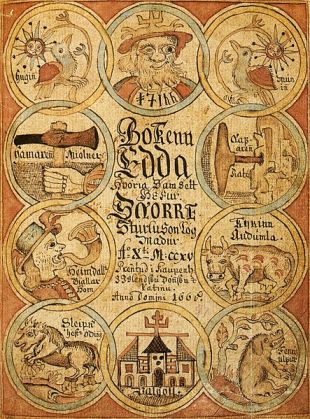In Norse mythology, Forseti is the god of justice and has the role of mediator among the gods. As the son of Baldur and the goddess Nanna, he is a central character, yet not well known. He is described as one always meets out a just and fair ruling in things.
I think he might have served as much as a role figure for justice in settling disputes, as a character in the larger Norse pantheon. In my view, many of the tales we have today, were likely seen as explanations and justifications for rules and order in Viking Age society. Having a fair arbitor of the peace seems like a good idea, and necessary in such a violent time.
Forseti Key Facts
| Parents | Baldur and Nanna |
| Partners | None known |
| Siblings | None known |
| Offspring | None known |
| Tribe | Aesir |
| Old Norse name | Forseti |
| Other names | Fosite, Foseti |
| The God of | Justice and Mediation |
| Ass. Animal | Ram |
Name and Etymology
Forseti, derived from the Old Norse term “for-sitja,” translates to “presiding one” or “president.” This name aptly captures his role as the god who presides over legal disputes, ensuring justice and fairness. In the realm of kennings, Forseti is only indirectly mentioned in one about Baldur. In the Skáldskaparmál, one of Baldurs’ kennings in ‘Father of Forseti’, emphasizing the lineage and connection to the god of light and purity.
Baldur is also seen as someone who is goodhearted and well meaning, basically a shining beacon of integrity. Who better to be the father of Forseti. Although a minor character, Forsetis’ mother Nanna is also cast as a wholesome goodhearted woman, her integrity beyond reproach. With such parents, I think Forseti was likely revered as just and kind.
Forseti’s Origins

Born to Baldur, the god of light and purity, and Nanna, the goddess of joy and peace, Forseti inherited a legacy of righteousness. His lineage alone positioned him as a beacon of fairness and justice among the gods.
Family and Relationships
Forseti, unlike many other gods, isn’t known for numerous romantic entanglements, or any to be fair. His primary focus remains on his divine duties, ensuring justice and fairness in all matters. Having said this, I want to add that while we can’t really know exaclty what we don’t know, it is certain that we have lost many stories about the gods. That we don’t know much about Forseti could mean that it is lost to us, but was well known back then.
Forseti’s Roles And Responsibilities
Forseti’s primary role in Norse mythology is that of an arbiter, ensuring justice and fairness in all disputes. His esteemed position is evident from the ancient texts, which describe his divine dwelling, Glitnir, as a place where conflicts are resolved. Crafted from gold and silver, Glitnir stands as a symbol of transparency, clarity, and the shining light of justice.

The Grímnismál from the Poetic Edda paints a vivid picture of Forseti’s daily life, where he spends most of his days in Glitnir, “solving all matters.”
Furthermore, Snorri Sturluson’s mention in the Prose Edda’s Gylfaginning reinforces Forseti’s role as the ultimate mediator. Snorri’s words, “All who come to him with disputes go away perfectly reconciled,” highlight Forseti’s unparalleled wisdom and fairness. Such mentions in revered texts solidify his position as a beacon of justice among both gods and mortals. In the grand tapestry of Norse deities, Forseti stands out, not for his prowess in battle, but for his dedication to upholding justice and ensuring harmony in the realms.
Depiction And Characteristics
Forseti’s actions in myths paint a picture of a calm, composed, and wise deity. He wasn’t one for battles or conquests; instead, he chose the path of understanding and mediation. His demeanor was always serene, reflecting his commitment to justice and fairness. While he might not have as many tales as Odin or Thor, his consistent portrayal as a just and fair god makes him a revered figure in Norse mythology.
Forseti’s Symbols, Artifacts or Animals
There are so few mentions of him in ancient manuscripts so it’s impossible to know if he had symbols, any special artifacts or animals associated with him. This actually lends credence to him being a late addition to the Old Norse pantheon than anything else. However, another possibility is that he has figured in myths which are now lost to us.
Play Fun Norse Quiz
Is this article making you even more curious about Norse gods and goddesses? You can satisfy your curiosity by playing a fun Norse mythology quiz. This way, you can test your knowledge about Norse gods and goddesses, as well as fill in some gaps. Good luck and have fun playing!
Don’t forget to try our other games as well!
Myths about Forseti
There are no myths associated with him and no one knows what might happen to him during Ragnarok. If he was indeed one of the true Aesir gods, it seems likley he died with most the others.
Mentions in Ancient Texts
While references to Forseti in ancient texts are sparse, his mention in the Grímnismál stands as a testament to his authenticity and significance within Norse mythology.
Poetic Edda

Grímnismál
The Grímnismál, a poem from the Poetic Edda, offers one of the earliest mentions of Forseti. In its 15th stanza, the poem describes Glitnir, Forseti’s dwelling-place, as a magnificent hall crafted from gold and silver. This hall serves as the venue where Forseti adjudicates disputes, ensuring fairness and justice.
The tenth is Glitnir; | with pillars of gold, And a silver roof; There Forseti lives | most of his days, Solving all matters.
Prose Edda
Gylfaginning
Penned by Snorri Sturluson, the Prose Edda’s Gylfaginning provides further insights into Forseti’s lineage and significance. In the 32nd verse of chapter 8, Snorri identifies Forseti as the offspring of Baldur and Nanna, emphasizing his noble heritage. This mention underscores Forseti’s esteemed position among the gods and his role in mediating conflicts.
32. Forsete is a son of Baldur and Nanna, Nep’s daughter. He has in heaven the hall which hight Glitner. All who come to him with disputes go away perfectly reconciled. No better tribunal is to be found among gods and men.
Frequently Asked Questions
He resided in Glitnir, a hall known for its silver roof and golden pillars.
Forseti is the son of Baldur, the god of light and purity, and Nanna, the goddess of joy and peace.
While many gods met their end during Ragnarok, Forseti’s fate remains a topic of debate, with some believing he survived the events.
Featured Image Credit: Carl Emil Doepler (1824-1905), Public domain, via Wikimedia Commons
